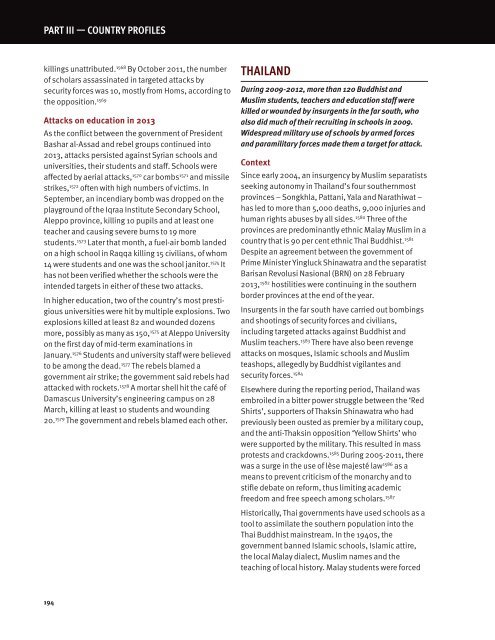You also want an ePaper? Increase the reach of your titles
YUMPU automatically turns print PDFs into web optimized ePapers that Google loves.
PART III — COUNTRY PROFILeS<br />
killings unattributed. 1568 By October 2011, the number<br />
of scholars assassinated in targeted attacks by<br />
security forces was 10, mostly from Homs, according to<br />
the opposition. 1569<br />
Attacks on education in 2013<br />
As the conflict between the government of President<br />
Bashar al-Assad and rebel groups continued into<br />
2013, attacks persisted against Syrian schools and<br />
universities, their students and staff. Schools were<br />
affected by aerial attacks, 1570 car bombs 1571 and missile<br />
strikes, 1572 often with high numbers of victims. In<br />
September, an incendiary bomb was dropped on the<br />
playground of the Iqraa Institute Secondary School,<br />
Aleppo province, killing 10 pupils and at least one<br />
teacher and causing severe burns to 19 more<br />
students. 1573 Later that month, a fuel-air bomb landed<br />
on a high school in Raqqa killing 15 civilians, of whom<br />
14 were students and one was the school janitor. 1574 It<br />
has not been verified whether the schools were the<br />
intended targets in either of these two attacks.<br />
In higher education, two of the country’s most prestigious<br />
universities were hit by multiple explosions. Two<br />
explosions killed at least 82 and wounded dozens<br />
more, possibly as many as 150, 1575 at Aleppo University<br />
on the first day of mid-term examinations in<br />
January. 1576 Students and university staff were believed<br />
to be among the dead. 1577 The rebels blamed a<br />
government air strike; the government said rebels had<br />
attacked with rockets. 1578 A mortar shell hit the café of<br />
Damascus University’s engineering campus on 28<br />
March, killing at least 10 students and wounding<br />
20. 1579 The government and rebels blamed each other.<br />
THAILAND<br />
During 2009-2012, more than 120 Buddhist and<br />
Muslim students, teachers and education staff were<br />
killed or wounded by insurgents in the far south, who<br />
also did much of their recruiting in schools in 2009.<br />
Widespread military use of schools by armed forces<br />
and paramilitary forces made them a target for attack.<br />
Context<br />
Since early 2004, an insurgency by Muslim separatists<br />
seeking autonomy in Thailand’s four southernmost<br />
provinces – Songkhla, Pattani, Yala and Narathiwat –<br />
has led to more than 5,000 deaths, 9,000 injuries and<br />
human rights abuses by all sides. 1580 Three of the<br />
provinces are predominantly ethnic Malay Muslim in a<br />
country that is 90 per cent ethnic Thai Buddhist. 1581<br />
Despite an agreement between the government of<br />
Prime Minister Yingluck Shinawatra and the separatist<br />
Barisan Revolusi Nasional (BRN) on 28 February<br />
2013, 1582 hostilities were continuing in the southern<br />
border provinces at the end of the year.<br />
Insurgents in the far south have carried out bombings<br />
and shootings of security forces and civilians,<br />
including targeted attacks against Buddhist and<br />
Muslim teachers. 1583 There have also been revenge<br />
attacks on mosques, Islamic schools and Muslim<br />
teashops, allegedly by Buddhist vigilantes and<br />
security forces. 1584<br />
Elsewhere during the reporting period, Thailand was<br />
embroiled in a bitter power struggle between the ‘Red<br />
Shirts’, supporters of Thaksin Shinawatra who had<br />
previously been ousted as premier by a military coup,<br />
and the anti-Thaksin opposition ‘Yellow Shirts’ who<br />
were supported by the military. This resulted in mass<br />
protests and crackdowns. 1585 During 2005-2011, there<br />
was a surge in the use of lèse majesté law 1586 as a<br />
means to prevent criticism of the monarchy and to<br />
stifle debate on reform, thus limiting academic<br />
freedom and free speech among scholars. 1587<br />
Historically, Thai governments have used schools as a<br />
tool to assimilate the southern population into the<br />
Thai Buddhist mainstream. In the 1940s, the<br />
government banned Islamic schools, Islamic attire,<br />
the local Malay dialect, Muslim names and the<br />
teaching of local history. Malay students were forced<br />
194


